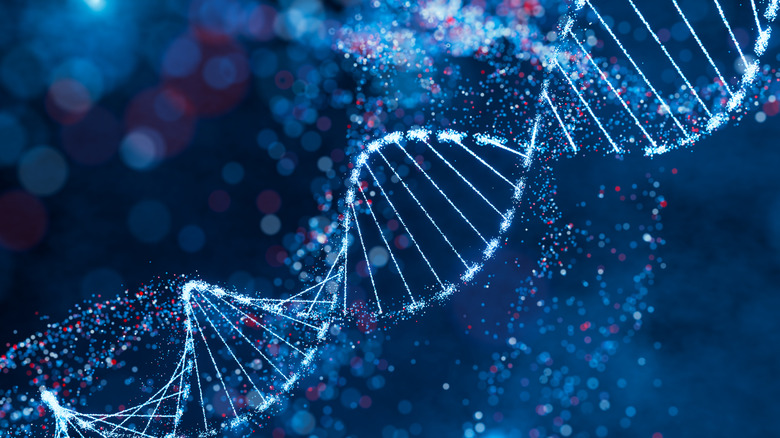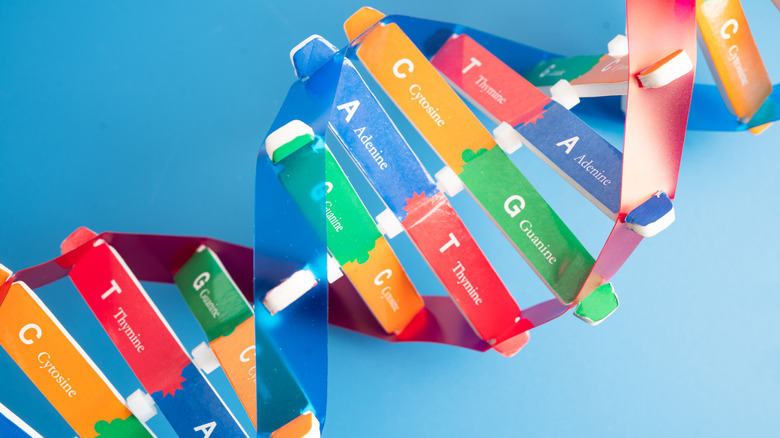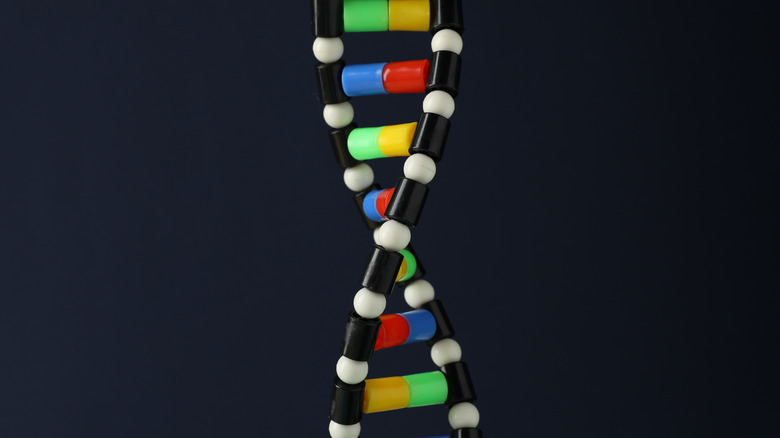The 3 Parts Of A Nucleotide Explained
Nucleotides are the building blocks of the two nucleic acids, ribonucleic acid (RNA) and deoxyribonucleic acid (DNA). As such, they are also the building blocks of you and every other lifeform on Earth. DNA stores all of the genetic information that gets passed down from one generation of organisms to the next, functioning like a blueprint for life. Its twisted, double-helix structure is one of the most iconic images in the scientific world.
RNA gets a little less attention than DNA, but it is no less important. RNA takes the genetic information stored in DNA and transfers it to structures within cells called ribosomes, which produce proteins based on the genetic blueprint. RNA consists of only one strand, unlike the double-helix of DNA. RNA molecules are also significantly shorter in length. Despite these differences, both types of nucleic acid are made from the same basic parts.
Nucleic acids are examples of polymers, which are long chains of molecules known as monomers. In the case of DNA and RNA, these monomers are nucleotides. Nucleotides themselves are composed of three distinct parts: sugar, phosphate, and a nitrogenous base. Here's what each of those really means.
Part 1: the nitrogenous base
Nitrogenous bases are composed of rings of interlinked nitrogen and carbon molecules. If a nitrogenous base is composed of two of these rings, it is known as a purine, but if it is only composed of one ring, it is called a pyrimidine. Purines and pyrimidines naturally bind to one another, like opposing ends of a magnet. In DNA, purines and pyrimidines bind with each other to form what are known as base pairs. If you imagine a double-helix strand of DNA as a twisted ladder, these nitrogenous base pairs are the rungs. There are also purines and pyrimidines in RNA, but since it is single-stranded, they are not bonded in base pairs.
There are two types of purine and three types of pyrimidine. The purines are adenine (A) and guanine (G), and they are found in both DNA and RNA. Pyrimidines are a little different. One type of pyrimidine, called cytosine (C), occurs in both types of nucleic acid. A second pyrimidine, called thymine (T), only occurs in DNA, while the third type, uracil (U), only occurs in RNA.
Nitrogenous bases are used when writing out genetic code. Gene codes are broken down into groups of three nucleotide bases, known as codons. Different codons indicate different amino acids that, when put together, create proteins. For example, the codons CAA and CAG create the amino acid glutamine. When all of the codons are put together, it spells out the entire genetic code.
Part 2: the pentose sugar
Pentose sugars form part of the backbone of DNA and RNA strands, the sides of the ladder, to go back to the analogy from earlier. All of the nucleotide bases in nucleic acids are bound to the first carbon atom of the pentose sugar. Pentose sugars are monosaccharides, types of carbohydrate molecules commonly referred to as simple sugars. They get their name from the fact that they have five carbon atoms, but even still, there are multiple varieties of pentose sugars.
The two most important types of pentose sugar are ribose and deoxyribose, and as you can probably guess from their names, these sugars are one of the main differentiators between RNA and DNA. The difference comes down to a single oxygen atom. Where ribose has a hydroxyl (OH) group attached to the second carbon in the ring, deoxyribose has only a hydrogen atom. The chemical formula for ribose is C₅H₁₀O₅, while the chemical formula for deoxyribose is C₅H₁₀O₄.
Part 3: the phosphate group
Pentose sugars aren't the only things that make up the backbones of DNA and RNA. Phosphate is also involved, creating what is known as a sugar-phosphate backbone. Phosphate is composed of one phosphorus atom and four oxygen atoms, and whenever it attaches to a carbon-containing molecule, as it does in nucleic acids, it is called a phosphate group.
Nucleotides can have one, two, or three phosphate groups, and this is used to differentiate between certain types of nucleotides. If there is only one phosphate group, the nucleotide is known as a nucleotide monophosphate. Two phosphate groups create a nucleotide diphosphate while three phosphate groups create a nucleotide triphosphate. However, when a nucleotide links to another nucleotide in a nucleic acid strand, it loses all but one of its phosphate groups.
Phosphate groups serve an incredibly important role in forming DNA and RNA strands by linking each nucleotide to the next. If you imagine a strand of nucleic acid as a train, phosphate groups are like the couplings that hold all of the train cars together. The phosphate group of one nucleotide connects to the sugar group of the next nucleotide, and so on to form the completed strands of DNA and RNA that give forth to life.



